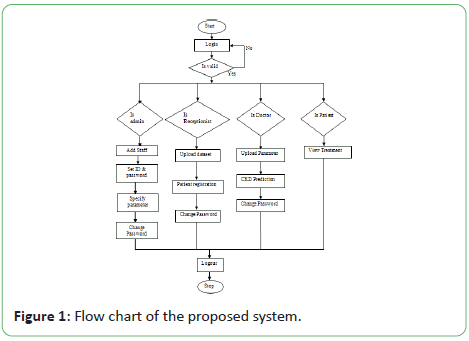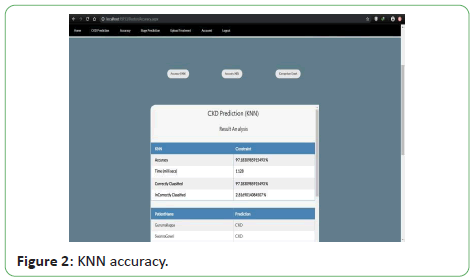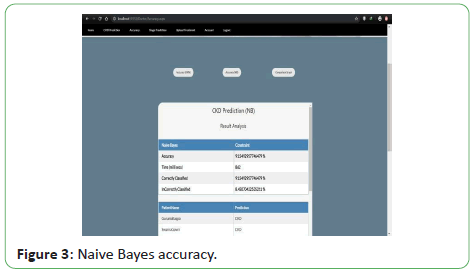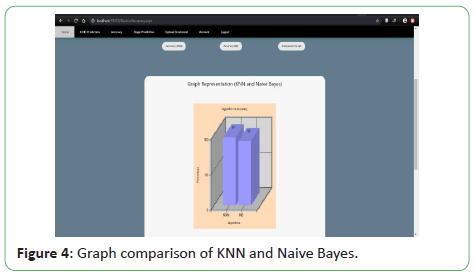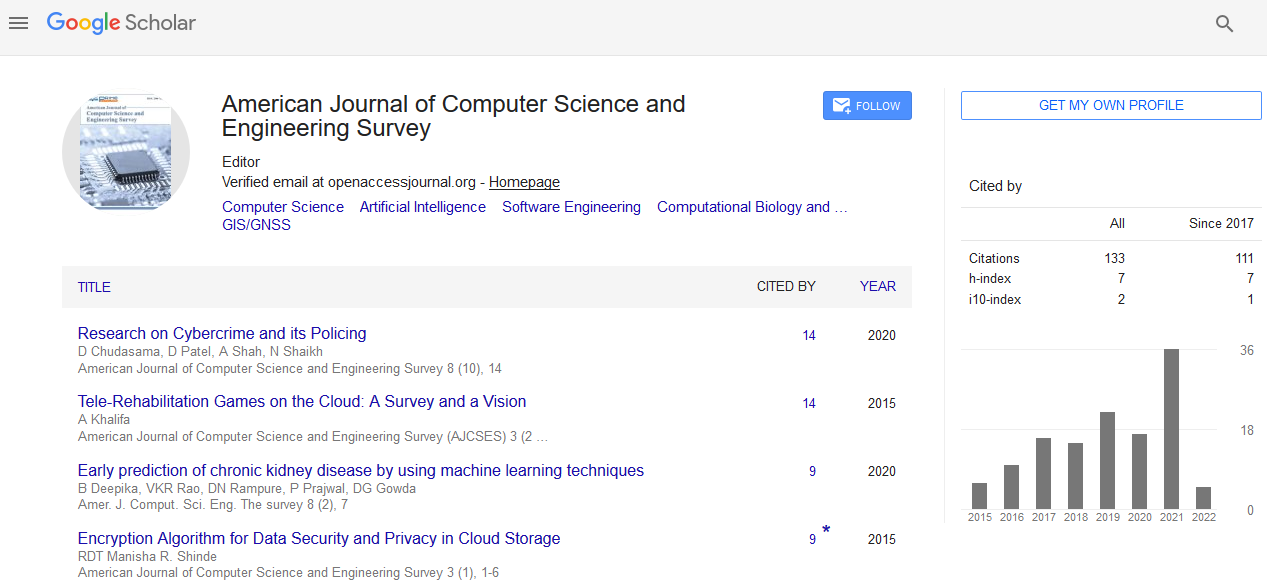Bidri Deepika*, Vasudeva Rao KR, Dharmaj N Rampure, Prajwal P and Devanand Gowda G
Department of Computer Science & Engineering, PES College of Engineering, Mandya, India
*Corresponding Author:
Deepika Bidri
Assistant Professor
Department of Computer Science & Engineering
PES College of Engineering, Mandya, India
E-mail: bdeepika@pesce.ac.in
Received Date: September 04, 2020; Accepted Date: September 18, 2020; Published Date: September 25, 2020
Citation: Deepika B, Rao VKR, Rampure DN, Prajwal P, Gowda DG, et al (2020) Early Prediction of Chronic Kidney Disease by using Machine Learning Techniques. Am J Comput Sci Eng Surv Vol. 8 No. 2:7.
Copyright: © 2020 Deepika B. This is an open-access article distributed under the terms of the Creative Commons Attribution License, which permits unrestricted use, distribution, and reproduction in any medium, provided the original author and source are credited.
Keywords
Chronic Kidney Disease (CKD); Naive bayes; K-Nearest neighbor;
Machine learning
Introduction
Currently, there are many people who are suffering from chronic
kidney diseases worldwide. Due to the several risk factors like
food, environment and living standards many people get diseases
suddenly. Diagnosing of chronic kidney diseases is generally
invasive, costly, time consuming and often risky. That is why many
patients reach latest age so fit without treatment, especially in
those countries where there sources are limited. Therefore,
the early detection strategy of the disease remains important,
particularly in developing countries, where the diseases are
generally diagnosed in later stages. Finding a solution for the
above-mentioned problems and riding out from disadvantages
became a strong motive to conduct this study. Chronic Kidney
Disease (CKD) is one of the types of kidney disease, which results
in a gradual loss of kidney function. This phenomenon can be
observed over a period of months or years due to several living
conditions of patients [1]. Kidney disease is broadly classified
into acute kidney injury and chronic kidney disease. Acute kidney
injury is sudden damage to the kidneys. In many cases it will be
short term but, in some people, it may lead to long-term chronic
kidney disease. Chronic kidney disease (CKD) means the kidneys are damaged and can’t filter blood the way they should. The
disease is called “chronic” because the damage to your kidneys
happens slowly over a long period of time. The main causes
are damaged blood vessels of the kidneys due to High Blood
Pressure and Diabetes. The CKD is also called a chronic kidney
failure where according current medical statistics the 10% of
the population worldwide is affected by CKD [2,3]. There were
approximately 58 million deaths in the year of 2005 worldwide.
According to the World Health Organization (WHO), 35 million
attributed to chronic diseases. Currently it is estimated that one
in five men, and one in four women aged 65 through 74 are going
to be affected by CKD worldwide. Diagnosing CKD usually starts
with clinical data, lab tests, imaging studies and finally biopsy.
In this study, by using the machine learning techniques, we are
proposing cheap, simple and non-invasive tests that can be
performed easily. The data has been obtained from the dataset
which is obtained from UCI machine learning repository for CKD
patients [4]. By this strategy, we hope to produce "down- staging"
(increasing in the proportion of CKD detected at an early stage)
of the disease to stages that are more amenable to curative
treatment.
Literature Survey
Kunwar, et al. entitled “Chronic Kidney Disease Analysis is Using
Data Mining Classification Techniques” published in 2016. Data
mining is the process of extracting hidden information from
massive dataset, categorizing valid and unique patterns in
data. There are many data mining techniques like clustering,
classification, association analysis, regression etc. The objective
of the paper is to predict Chronic Kidney Disease (CKD) using
classification techniques like Naive Bayes and Artificial Neural
Network (ANN). The experimental results implemented in
Rapid Miner tool show that Naive Bayes produce more accurate
results than Artificial Neural Network [5]. Amirgaliyev, et al.
entitled “Analysis of Chronic Kidney Disease Dataset by Applying
Machine Learning Methods” published in 2015. Currently, there
are many people in the world suffering from chronic kidney
diseases worldwide. Due to the several risk factors like food,
environment and living standards many people get diseases
suddenly without understanding of their condition. In this
research study, the effects of using clinical features to classify
patients with chronic kidney disease by using support vector
machines algorithm is investigated. The chronic kidney disease
data set is based on clinical history, physical examinations, and
laboratory tests [6]. Devika, et al. entitled “Comparative Study
of Classifier for Chronic Kidney Disease Prediction Using Naive
Bayes, KNN and Random Forest” published in 2019. Chronic
Kidney disease defines constrains which affects your kidneys
and reduces your potential to stay healthy. Machine learning
is an important task as it benefits many applications, varied
knowledge mining classification approaches and machine
learning algorithms are applied for prediction of chronic diseases.
Therefore, this paper examines the performance of Naive Bayes,
K-Nearest Neighbor (KNN) and Random Forest classifier on the
basis of its accuracy, preciseness and execution time for CKD
prediction. Finally, the outcome after conducted research is that
the performance of Random Forest classifier is finest than Naive
Bayes and KN [7]. Avci E et al. entitled “Performance Comparison
of Some Classifiers on Chronic Kidney Disease Data” published
in 2018. In this study, dataset named "Chronic Kidney Disease"
obtained from UCI database is used. The dataset consists of
400 individual’s information and contains 25 features dataset
was classified according to whether it is chronic kidney disease
using Naive Bayes (NB), K-Star, Support Vector Machines (SVM)
and J48 classifiers used in data mining [8]. Dulhare, et al. entitled
“Extraction of Action Rules for Chronic Kidney Disease using Naive
Bayes Classifier” published in 2017. Chronic kidney disease (CKD),
also known as chronic renal disease, which is a progressive loss in
kidney function over a period of months or years. It is defined by
the presence of kidney damage or decreased glomerular filtration
rate (GFR). The estimated prevalence of CKD is about 9-13 % in
the general adult population. Chronic Kidney Disease is a silent
condition. Signs and symptoms of CKD, if present, are generally
not specific in nature and unlike several other chronic diseases
(such as congestive heart failure and chronic obstructive lung
disease), they do not reveal a clue for diagnosis or severity of the
condition. Early detection and treatment can often keep chronic
kidney disease from getting worse [9]. Aljaaf, et al. entitled “Early Prediction of Chronic Kidney Disease Using Machine Learning
Supported by Predictive Analytics” published in 2018.Chronic
Kidney Disease is a serious lifelong condition that induced by
either kidney pathology or reduced kidney functions. Early
prediction and proper treatments can possibly stop, or slow the
progression of this chronic disease to end-stage, where dialysis
or kidney transplantation is the only way to save patient’s life.
In this study, we examine the ability of several machine-learning
methods for early prediction of Chronic Kidney Disease [10].
Materials and Methods
Proposed method
Chronic kidney disease (CKD) has become a global health
issue and is an area of concern. It is a condition where kidneys
become damaged and cannot filter toxic wastes in the body.
The proposed system predominantly focuses on predicting this
life-threatening disease Chronic Kidney Disease (CKD) using
Classification algorithms (KNN and Naive Bayes). Proposed
system is automation for chronic kidney disease prediction using
classification techniques and supervised learning algorithms. The
data for dataset is obtained from UCI machine learning repository
which contains 25 parameters (features) including the class (CKD
or NOT CKD) is given in Table 1.
| Attribute name |
Value range |
Description |
| Age |
2,…,90 |
Age |
| BP |
50,…,180 |
Blood Pressure |
| SG |
1.005, 1.010, 1.015, 1.020, 1.025 |
Specific Gravity |
| Al |
0,1,2,3,4,5 |
Albumin |
| Su |
0,1,2,3,4,5 |
Sugar |
| RBC |
2,1,…,8 |
Red Blood Cells |
| PC |
Normal, abnormal |
Pus Cell |
| PCC |
Present, not present |
Pus Cell Clumps |
| Ba |
Present, not present |
Bacteria |
| BGR |
22,…,490 |
Blood Glucose Random |
| BU |
1.5,,…,391 |
Blood Urea |
| SC |
0.4,…,76 |
Serum Creatinine |
| Sod |
4.5,…,163 |
Sodium |
| Pot |
2.5,…,47 |
Potassium |
| Hemo |
3.1,…,17.8 |
Haemoglobin |
| PCV |
9,…,54 |
Packed Cell Volume |
| WBC |
2200,…,26400 |
White Blood Cell Count |
| RBC |
2.1,…,8 |
Red Blood Cell Count |
| Htn |
Yes, no |
Hypertension |
| DM |
Yes, no |
Diabetes Mellitus |
| CAD |
Yes, no |
Coronary Artery Disease |
| Appet |
Good, poor |
Appetite |
| PE |
Yes, no |
Pedal Edema |
| Ane |
Yes, no |
Anemia |
| Class |
Ckd, not ckd |
Class |
Table 1: Dataset parameters.
The proposed system uses Naive Bayes and K-Nearest Neighbor
algorithms for classification. Also, it predicts the stage of the CKD.
The entire system is built as a real time application which contains
4 modules (Admin, Receptionist, Doctor and Patient).
The workflow of the proposed system is shown in Figure 1.
Figure 1: Flow chart of the proposed system.
Results
The application uses KNN and Naive Bayes Algorithms for
classification. The application has Admin module which is the main
module to maintain the application. After admin’s successful login
he can add doctors and receptionists. The receptionist will add
the training dataset (old patient) and register’s the new patient.
Doctor can analyze whether a patient have CKD or not and also
determine the CKD stage if patient having CKD. Also, doctors
have an option to upload treatment details for particular patient.
The patient can view his treatment details by logging in to the
application. When multiple patient data is analyzed, we got 97%
of accuracy using KNN is shown in Figure 2 and 91% of accuracy
using Naive Bayes is shown in Figure 3. Graph Comparison of KNN
and Naive Bayes is shown in Figure 4.
Figure 3: Naive Bayes accuracy.
Figure 4: Graph comparison of KNN and Naive Bayes.
Conclusion
This project is a medical sector application which helps the
medical practitioners in predicting the CKD disease based on the
CKD parameters. It is automation for CKD disease prediction and
it identifies the disease, its stages in an efficient and economically
manner. It is successfully accomplished by applying the KNN
and Naive Bayes algorithms for classification. This classification
technique comes under data mining technology. This algorithm
takes CKD parameters as input and predicts the disease based on
old CKD patient’s data.
Future Enhancements
SMS/Email module
In the proposed system, admin assigns Id and password for
doctors and receptionists and is intimated manually, so we can
add SMS/Email module as a future enhancement where doctors
and receptionists receive an SMS or Email regarding the Id and
password.
Query module
We can add the query module as a future enhancement to
the application where doctor, receptionist and admin of the
application can interact with each other.
References
- Noia TD, Ostuni VC, Pesce F, Binetti G, Naso D, et al. (2013) An end stage kidney disease predictor based on an artificial neural network ensemble. Expert Syst Appl 40: 4438–4445.
- Levey AS, Atkins R, Coresh RJ, Cohen EP, Collins AJ, et al. (2007) Chronic kidney disease as a global public health problem: approaches and initiatives - a position statement from Kidney Disease Improving Global Outcomes. Kidney Int 72: 247-259.
- Jha V, Garcia-Garcia G, Iseki K, Li Z, Naicker S, et al. (2013) Chronic kidney disease: global dimension and perspectives. Lancet 382: 260- 272.
- Soundarapandian P (2015) Chronic Kidney Disease Data Set. UCI Machine Learning Repository, Center for Machine Learning and Intelligent Systems, Irvine, CA: University of California, School of Information and Computer Science.
- Kunwar V, Chandel K, Sai Sabitha A, Bansal A (2016) Chronic Kidney Disease Analysis Using Data Mining Classification Techniques. 2016 6th International Conference-Cloud System and Big Data Engineering.
- Amirgaliyev Y, Shamiluulu S, Serek A (2018) Analysis of Chronic Kidney Disease Dataset by Applying Machine Learning Methods. 2018 IEEE 12th International Conference on Application of Information and Communication Technologies (AICT).
- Devika R, Sai Vaishnavi A, Subramaniyaswamy V (2019) Comparative Study of Classifier for Chronic Kidney Disease Prediction Using Naive Bayes, KNN and Random Forest. 2019 3rd International Conference on Computing Methodologies and Communication (ICCMC).
- Avci E, Karakus S, Ozmen O, Avci D (2018) Performance Comparison of Some Classifiers on Chronic Kidney Disease Data. 2018 6th International Symposium on Digital Forensic and Security (ISDFS).
- Dulhare UN, Ayesha M (2016) Extraction of Action Rules for Chronic Kidney Disease using Naive Bayes Classifier. 2016 IEEE International Conference on Computational Intelligence and Computing Research (ICCIC).
- Aljaaf AJ, Al-Jumeily D, Haglan HM, Alloghani M, Baker T, et al. (2018) Early prediction of chronic kidney disease using machine learning supported by predictive analytics. 2018 IEEE Congress on Evolutionary Computation (CEC).

